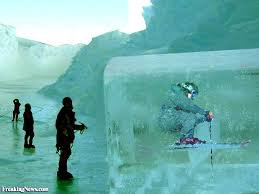What You Need to Know Part 1: Prevention and Frostnip?
A few years back, my wife and I were riding a quad chair at Sugarloaf in western Maine, and I started chatting up the young snowboarder sitting with us. It was a bitterly cold day – full balaclava weather – and when Lauri, a medical professional, looked over at our lift partner, she immediately interrupted us.
"You need to get inside, now," she told the teenager, with an edge in her voice that didn't invite debate. "You've got frostbite, Bad."
That's when I noticed the waxy complexion on the young man's cheeks and nose. The teen said he felt fine, but Lauri persisted. "I'm telling you, you need to go to First Aid."
As we parted ways at the top of the lift, my wife shook her head.
"That boy is going to be in a world of hurt later today," said Lauri. "Frostbite is no fun."
That's one of the most insidious things about frostbite, and several other winter-related maladies, like altitude sickness, dehydration and hypothermia. Pain isn't the first indicator that something has gone wrong. Once you start hurting, you're already in deep. So you've got to be aware, and be prepared, for anything that Old Man Winter can throw at you.
Now, consider that skiing and snowboarding often involve hurtling down a mountainside at a good clip, with lots of other folks, and you can add the threat of impact injury. Suffice to say, it can be dangerous out there on the slopes.
Prevention
A big part of the Skier's Responsibility Code is being personally responsible for your own well-being. That means skiing conscientiously and within your abilities, dressing properly for the elements, and knowing when to come in from the cold. These problems can happen at fully staffed resorts, or in the backcountry. In short, they can happen anywhere.
My brother Sean, an orthopedic surgeon, is a member of the medical staff at
Loon Mountain in New Hampshire, and he's seen ski-related injuries that run the gamut, from dehydration to ACL tears and concussions (and worse). Most, he says, are preventable. So with that caveat in mind, it behooves anyone heading to the hill to understand the possibility of injuries.
First, dress properly (helmets, while not required, are highly recommended), in layers, with good eye protection (polarized goggles are superior to sunglasses). Balaclavas, neck gaiters, glove and boot liners, and hard and foot warmers can be the difference between a memorable day on the hill and misery (and a great reason to invest in a boot bag, so you can easily carry these accessories). While you're at it, toss in some lip balm and sunscreen. Make sure you're properly hydrated. And have your equipment, especially bindings, checked routinely by a qualified ski technician.
Finally, remember that accident avoidance is the best option. Adhere to the general rules of skier etiquette (uphill skier must avoid the downhill skier, etc.). Most skiers and snowboarders – especially beginners – have suffered their fair share of bumps and bruises. Those are just a rite of passage. But more serious injuries, whether inflicted by Mother Nature or self-inflicted, require special care.
Frostbite
When body parts – typically extremities like toes, fingers, earlobes, chin, cheeks and nose – are exposed to extreme cold for a period of time, the blood vessels in those areas constrict. When body temperatures drop, the fluid within the cells can begin freezing and forming ice crystals, which can cause cells to rupture. Pretty gruesome, right?
The good news is that frostbite is far more uncommon than its lightweight cousin, "frostnip." Frostnip occurs on the surface, where exposed skin can feel stiff and numb and takes on a whitish hue, but the underlying tissue remains warm and soft. While relatively benign – frostnip doesn't require medical attention – it is usually the first step to developing frostbite. So check often. To treat, warm the exposed skin by rubbing, and covering with extra layers.
If frostnip remains unchecked, it can lead to superficial frostbite. This condition is described as hard, frozen skin that looks bluish white. While the underlying tissue hasn't yet been affected, superficial frostbite can cause blistering, and proper medical attention is required to prevent permanent injury. Further exposure can lead to deep frostbite, which affects the tissue underneath. The skin is white/blue and completely frozen, and the tissue is hard as well. Deep frostbite should be treated immediately, which if can lead to permanent injury to nerves and muscle tissue, amputation, and even death.
Continue to:
Altitude sickness, impact injuries and hypothermia.
Related Posts:
Skiing Advice for Intermediates
Skiing Etiquette
Printable Ski Gear Checklist (PDF)
How to Find a Ski Partner

